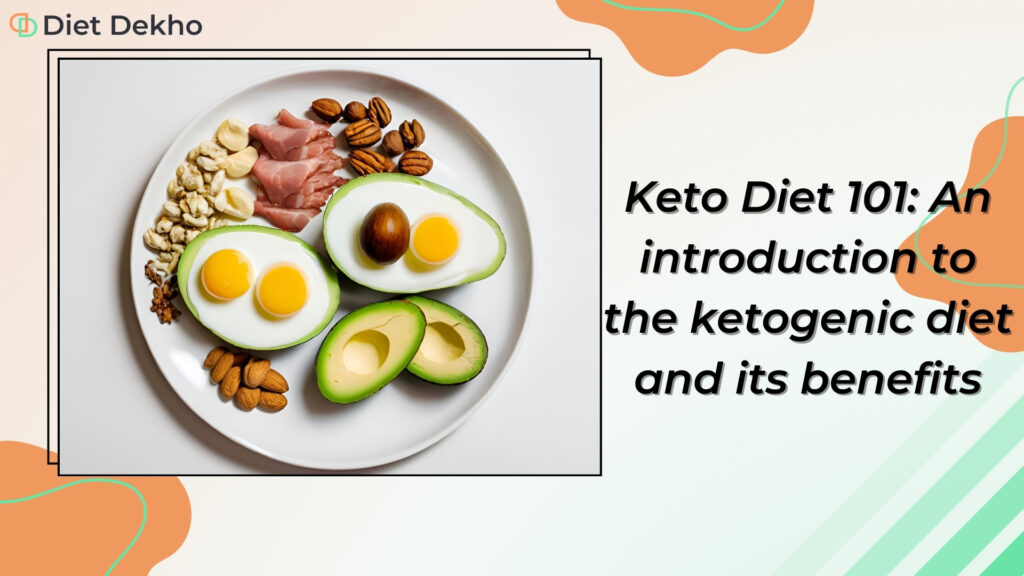The keto diet has recently gained immense popularity. This is because of its efficacy in forcing fat loss at super high speeds and improving general health. The diet can be traced back to some decades ago but was never embraced by the mass population except as a medicinal strategy. This was before it was seen as a good way to lose weight and boost mental and physical energy. This blog will broadly introduce the ketogenic diet. It will outline its benefits and risks before adopting this new lifestyle.

What Is Ketogenic Diet?
This is an eating lifestyle. It is a low-carb, high-fat diet. It has been used for nearly a century to treat some medical conditions, especially epilepsy. The diet essentially modifies the body’s fuel source from carbohydrates to fats. Ketosis is a state where the body relies on fat for energy due to very low glucose (sugar) levels. The liver makes ketones from fat stores to use them as an alternative energy source.
Here are the general macronutrient ratios for a ketogenic diet:
Fat: 70-75%
Protein: 20-25%
Carbohydrates: 5-10%
This has the body falling into a state of ketosis, where fat becomes the main source of energy.
Ketosis Mechanism
Normally, with diets, the carbohydrates taken are transformed into glucose, which is the major source of energy in the body. If carbohydrate levels drop, the body seeks other energy sources. That’s when ketosis begins.
Ketosis occurs when the liver breaks down fatty acids into ketone bodies. They are good for the brain and other tissues. The three dominant types of ketones produced include:
Acetoacetate: This is the first one produced and later transformed into other ketone bodies.
Beta-hydroxybutyrate (BHB): The most abundant and most efficient ketone body used for energy.
Acetone: It is exhaled and causes part of the distinct “keto breath” some people experience.
Ketosis mimics the body’s natural fasting state. It lets the body use stored fats for energy. It maintains muscle mass and boosts mental sharpness.
Ketogenic Diet Benefits
The Ketogenic Diet has many benefits. This makes it a popular choice for various health goals, including:
Weight Loss
A popular benefit, and one of the most common during the keto diet, is weight loss. The keto diet reduces the body’s reliance on glucose for energy and instead focuses on the burning of fat, which reduces body fat. The high-fat diet is very filling. It keeps hunger and cravings in check. So, it naturally lowers calorie intake.
Improved Mental Clarity and Focus
The brain effectively utilizes ketones as fuel, giving one greater clarity and better mental function. Many people claim they feel more focused, remember more, and pay better attention while on a ketogenic diet.
Better Energy and Endurance
While glucose manufactures peaks and valleys in one’s energy, ketones offer a much smoother and more sustained energy flow. This could, in theory, affect endurance. It is a concern for athletes in long endurance events.
Blood Sugar Control
The ketogenic diet can quickly lower blood sugar levels. So, it is great for people with type 2 diabetes or prediabetes. Reducing carbohydrates in the diet stabilizes blood sugar. This should lower the need for glucose-control medications.
Reduced Inflammation
Chronic inflammation is linked to many health issues which include heart disease, cancer, and autoimmune disorders. The keto diet reduces inflammation and promotes wellness.
Epilepsy and Neurological Disorders
The ketogenic diet was designed to treat epilepsy, especially in children whose seizures did not respond to standard drugs. It has been efficient in reducing the frequency and severity of the seizures. It has also shown promise in treating Alzheimer’s, Parkinson’s, and multiple sclerosis, to some extent.

How to Start the Ketogenic Diet
This diet is hard to start. But, it ensures you are working towards a well-planned goal. It requires major changes to your diet. Here is a simple process on how to begin:
a.Count your macros
The first thing you need to do to calculate is your macronutrient needs—how many grams of fat, protein, and carbs to take on a daily basis. There are many calculators online for your ideal macros, factoring in one’s age, weight, activity level, and goal.
b. Choose Keto-Friendly Foods
To be able to succeed in your keto diet, it is imperative that the foods you consume be high in fat, moderate in protein, and lo-o-ow in carbs. These include:
Fats and Oils: Olive oil, coconut oil, avocado oil, butter, ghee
Meats: Beef, pork, chicken, turkey, lamb
Fish and Seafood: Salmon, mackerel, sardines, shrimp, crab
Dairy: Cheese, heavy cream, Greek yogurt
Nuts and Seeds: Almonds, walnuts, chia seeds, flaxseeds
Low-Carb Vegetables: Leafy greens, broccoli, cauliflower, zucchini, bell peppers
Berries: Strawberries, raspberries, blueberries (in moderation)
c. Avoid High-Carb Foods
Eliminate foods high in carbohydrates from your diet. This includes:
Grains (bread, rice, pasta, cereals)
Starchy vegetables (potatoes, sweet potatoes, corn)
Sugary foods (soda, candy, pastries, desserts)
Most fruits (bananas, apples, oranges)
d. Plan Your Meals
Meal planning is essential for the success in keto diet. Meal prepping makes it easier to hit your carb, fat, and protein goals. It also helps you resist cravings for high-carb foods. Ensure that you aim for meals that are primarily composed of a good source of fats, a moderate source of protein, and a vegetable with a low-carb count.
e. Stay Hydrated
The keto diet may increase urination due to increased hydration. If followed, drink plenty of water. If needed, take electrolytes, including sodium, potassium, and magnesium.
f. Monitor Your Progress
Testing and monitoring guarantee that one is in ketosis and attains desired health outcomes. Ketone strips, blood ketone meters, and food tracking apps help monitor your ketones and make changes in your diet when necessary.
Possible Side Effects and Considerations
The ketogenic diet has many benefits. But, it has side effects. There are also some important things to consider when starting the diet. Commonly reported complaints include :
a. The Keto Flu
Symptoms of the “keto flu” would usually develop within the first couple of weeks of the diet. Patients have reported experiencing headaches, fatigue, irritability, nausea, and dizzy spells. This is due to the body trying to adapt to the changed metabolic pathways that are enabled in a patient. These symptoms are treatable simply by maintaining a state of hydration and electrolyte care.
b. Upset Stomach
A sudden spike in fat intake and a low level of fiber can cause digestive issues, among which constipation is a prevailing problem. To counter it, add low-carb and high-fiber vegetables, as well as a fiber supplement if necessary.
c. Nutrient Deficiencies
Cutting out various groups of food may result in nutrient deficiency if not properly managed. A well-formulated keto diet will include nutrient-rich foods. Supplements like multivitamins, omega-3 fatty acids, and vitamin D could help bridge the nutritional gap.
d. Compliance and Continuation
A ketogenic diet is a major lifestyle change and very troublesome for some people to comply with. Social outings, eating at a restaurant, and food cravings can be tricky. It is important to see the diet as a new lifestyle. It should not be a fire brigade approach. This view will help achieve long-term health and well-being.
e. Medical conditions and contraindications
While most people can safely utilize the ketogenic diet, some people should not. Health issues that might affect one in this diet include pancreatitis, liver failure, or gallbladder disease. Professional guidance should be sought before making such dramatic changes by women who are pregnant or nursing.
The Long Term Effect of the Ketogenic Diet
Although the ketogenic diet itself is still being studied for long-term effects, most of the people who do it enjoy its benefits over a long time. However, we should consider its risks and adjust accordingly. In fact, some people may need to be weaned onto a more moderate low-carb diet once their health goals are met in order to sustain them.
The possible long-term side effects that could ensue from a ketogenic diet include:
Weight Maintenance: Many people maintain their weight loss by using a modified, lower-carb version of the keto diet.
Improved Metabolic Health: This diet improves insulin sensitivity, cholesterol, and blood pressure.
Potential Cardiovascular Risk: A keto diet will improve heart health for most. But, its high saturated fat content may harm those with heart disease. One should focus on healthy fats like olive oil, avocados, and fatty fish.
Bone Health: Some researchers say chronic ketosis may lower bone density. It may alter calcium metabolism. Optimal calcium, vitamin D intakes, and weight-bearing exercise would reduce this risk.

Adapting the Ketogenic Diet to Your Lifestyle
Although the ketogenic diet is very effective, it is important to personalize it based on your needs and lifestyle. Here’s how you can do it: a.Personalized Macros
Not everybody’s body reacts in the same way to the ketogenic diet. Alter your macronutrient ratios according to your desired goal, activity level, and the way your body feels. It might be fitting to have a little more protein or fewer fats, which will also get you optimum results.
b. Engage in Body Exercise
Yes, you lose weight even without exercising, but combining it with physical activity can make the effect even better. Strength training, cardio, and flexibility workouts will help you. They will build muscle, raise your metabolism, and improve your fitness.
c. Look for Alternatives in the Keto Diet
This is tough when you crave your favorite carbs. But, there are many keto-friendly substitutes. You can find everything from almond flour bread to sugar-free snacks. Try a few new recipes to make your meals enjoyable and satisfying.
d. Prepare for Social Situations
Social events and dining out can sometimes be a bit tricky while on a keto diet. Plan ahead by researching menus, and take a few extra minutes to show up with some keto-friendly dishes in tow. Don’t hesitate to make special requests or substitutions when eating out.
e. Listen to Your Body
The ketogenic diet is not one-size-fits-all. See what works for your body and make the necessary adjustments. If you get side effects, like fatigue or digestive issues, try a varied diet. If that doesn’t help, seek medical advice.
The Future of the Ketogenic Diet
More studies on the long-term effects and research on the applications of the diet will only increase its popularity. An ever-growing number of studies suggest the keto diet may help treat cancer, improve mental health, and increase longevity. You need to focus on the diet itself. It should consider both its benefits and its possible downsides.
Consultation with a health professional or dietitian could be issued to anyone wanting to go on the ketogenic diet. Make the diet personal, according to your needs and goals, to get the most benefits and ensure the results will last.

Conclusion
This diet is not far from being a magic pill in the aspect of being a mighty tool for health improvement, weight loss, and overall well-being. By learning the principles of the diet, it will greatly help embrace the benefits and thus make an informed choice on keto. A ketogenic diet can help you. It is a science-backed way to lose weight, control a medical condition, or just feel your best. As with all diets, what works for one person might not for another, so it’s important to listen to one’s own body and adjust accordingly. A ketogenic diet can be a transformational experience with the right mindset and commitment.
